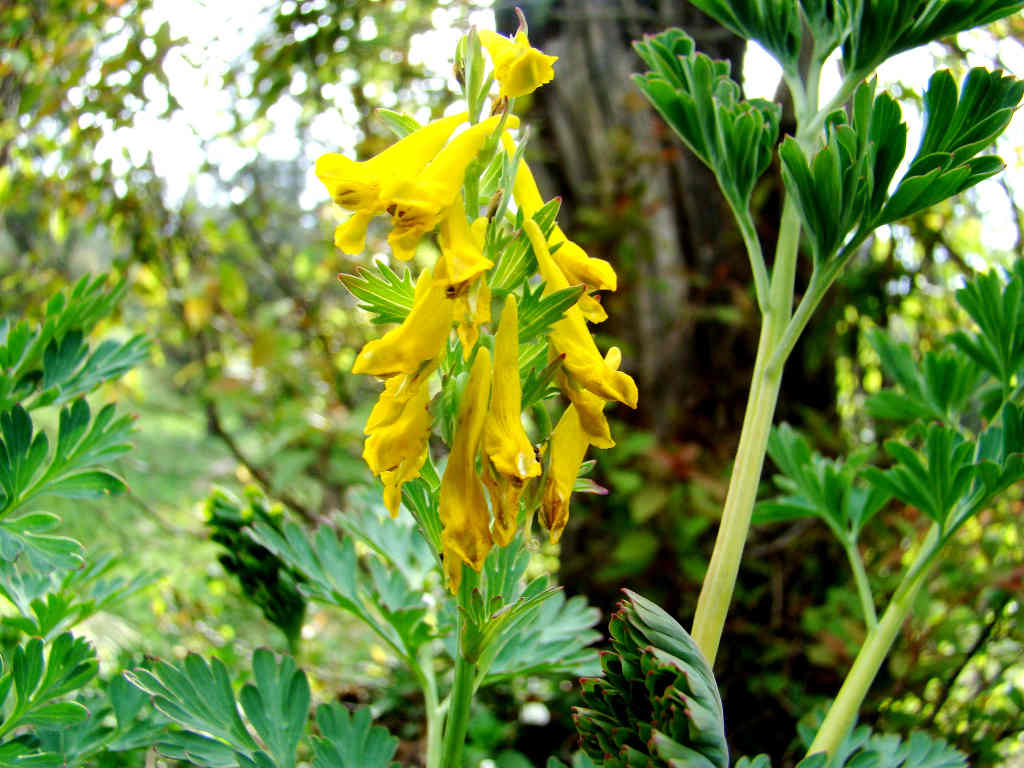
Govan’s Corydalis (Bhootkashi)
Govan’s Corydalis (Corydalis govaniana), commonly known as Bhootkashi, is a medicinal plant native to the Himalayan region. Found predominantly in the temperate and subalpine zones of the Himalayas, including areas within the Great Himalayan National Park (GHNP), this plant is recognized for both its botanical significance and its role in traditional healing systems.
Habitat and Distribution in the Himalayas
Govan’s Corydalis thrives in moist, shaded environments at elevations between 2,500 and 4,000 meters. It is commonly found in rocky slopes, meadows, and forest edges across the Himalayan belt, especially in Himachal Pradesh, Jammu & Kashmir, and parts of Nepal. Within the Great Himalayan National Park, this plant flourishes in areas with well-drained soils, where the cool temperatures and adequate moisture levels support its growth.
Botanical Characteristics
Govan’s Corydalis is a perennial herb with distinctive yellowish-green flowers that form in dense clusters. The plant typically reaches heights of 30 to 45 cm. Its feather-like leaves are deeply divided, giving it a delicate and feathery appearance. The flowers bloom in late spring to early summer, making it an attractive addition to the Himalayan meadows during this period.
The plant’s tubular flowers are typically yellow to greenish-yellow and possess a sweet fragrance that attracts various pollinators, such as bees and butterflies. The plant’s unique structure and color make it easily identifiable among the rich diversity of plants in the Himalayan flora.
Medicinal and Therapeutic Uses
In traditional Himalayan medicine, Govan’s Corydalis (Bhootkashi) is highly valued for its medicinal properties, particularly in Ayurvedic and Tibetan medicine. It is believed to possess various bioactive compounds that contribute to its healing effects, and it is used for treating a variety of ailments. Some of its most notable uses include:
-
Pain relief: The plant is often used to reduce muscle and joint pain.
-
Digestive health: It is believed to aid in treating indigestion, gastric disorders, and stomach discomfort.
-
Anti-inflammatory properties: Govan’s Corydalis is used in remedies to reduce inflammation and swelling in conditions like arthritis and gout.
-
Neurological support: Some practitioners use it as a remedy for headaches and nervous system disorders, though its use should always be supervised due to its potency.
Local name
Govan’s Corydalis (Bhootkashi)
Botanical name
Corydalis govaniana
Family
Fumariaceae (Fumitory family)
Description and uses
Govan’s Corydalis is an erect, tufted, perennial herbs, 15-70 cm tall, usually simple, often with leaves arising from roots, as long as the stem, and 0-2, opposite leaves down below the stem. Rootstock thickened, covered with withered sheathing bases of leaves. Stem leaves, if present, are deeply lobed. Yellow flowers occur in 10-25 -flowered racemes, generally simple, often dense, 5-10 cm long, increasing upto 15 cm in fruit. Flowers are 2-2.5 cm long, with the spur making up half the length of the flower. Found in the Himalayas at altitudes of 2400-4800 m. Flowering: May-August.
Ecological Role and Conservation
Govan’s Corydalis plays an important ecological role in the Himalayan ecosystem. Its roots help prevent soil erosion in the rugged mountainous regions where it grows. As a part of the native flora, it contributes to the biodiversity of the region and provides a food source for various pollinators, ensuring the balance of the ecosystem.
However, Govan’s Corydalis is vulnerable to over-harvesting due to its medicinal value. The increasing demand for its medicinal use and the destruction of natural habitats due to human activity in the Himalayan regions pose significant threats to its survival. Conservation efforts within protected areas like the Great Himalayan National Park are crucial to ensure that the species is preserved for future generations.
Conclusion
Govan’s Corydalis (Bhootkashi) is a remarkable herb that plays a key role in both the medicinal and ecological landscapes of the Himalayan region. Its beautiful flowers, alongside its significant medicinal properties, make it an important species worth conserving. Sustainable harvesting and protection of its natural habitats are essential to maintaining the delicate balance of the Himalayan ecosystems and ensuring the continued availability of this valuable plant.



